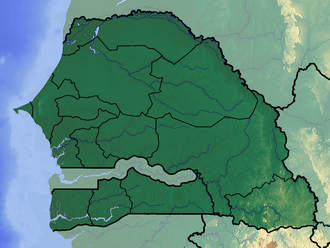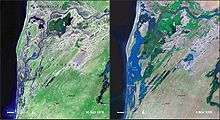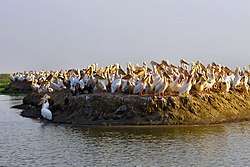Djoudj National Bird Sanctuary
The Djoudj National Bird Sanctuary (French: Parc national des oiseaux du Djoudj) lies on the southeast bank of the Senegal River in Senegal, in northern Biffeche, north east of St-Louis.
| Djoudj National Bird Sanctuary | |
|---|---|
IUCN category II (national park) | |
 | |
| Location | Senegal |
| Coordinates | 16°30′N 16°10′W |
| Area | 160 km2 |
| Established | April 14, 1971 |
| Type | Natural |
| Criteria | vii, x |
| Designated | 1981 (5th session) |
| Reference no. | 25 |
| State Party | |
| Region | Africa |
| Endangered | 1984–1988; 2000–2006 |
| Official name | Parc National des Oiseaux du Djoudj |
| Designated | 11 July 1977 |
| Reference no. | 138[1] |
It provides a range of wetland habitats which prove very popular with migrating birds, many of which have just crossed the Sahara. Of almost 400 species of birds, the most visible are pelicans and flamingos. Less conspicuous are the aquatic warblers migrating here from Europe; for these, the park is the single most important wintering site yet discovered . A wide range of wildlife also inhabits the park, which is designated a World Heritage Site. The site was added to the list of World Heritage in Danger in 2000 due to the introduction of the invasive giant salvinia plant, which threatens to choke out the park's native vegetation. However it was removed from the list in 2006.
Environmental issues

Since operation of the Diama Dam on the Senegal River began in 1988, experts have observed a lowering of the water level, desalinization, and silting. The changes pose a threat to the fauna and flora. There has been in particular a proliferation of typhas and Phragmites. To the left, satellite photos take by NASA in 1979 (before construction of the dam) and 1999 (afterwards) give evidence of the significant impact on the region's ecosystem.
In 2006, though no cases of avian flu had been reported in Senegal, a monitoring program was put into effect.
References
- "Parc National des Oiseaux du Djoudj". Ramsar Sites Information Service. Retrieved 25 April 2018.
- WCMC Natural Site Data Sheet
- Official UNESCO website entry
- Ministère de l’Environnement, de la Protection de la nature, des Bassins de rétention et des Lacs artificiels: Parcs et réserves, 13 October 2005.


| Wikimedia Commons has media related to Djoudj National Bird Sanctuary. |